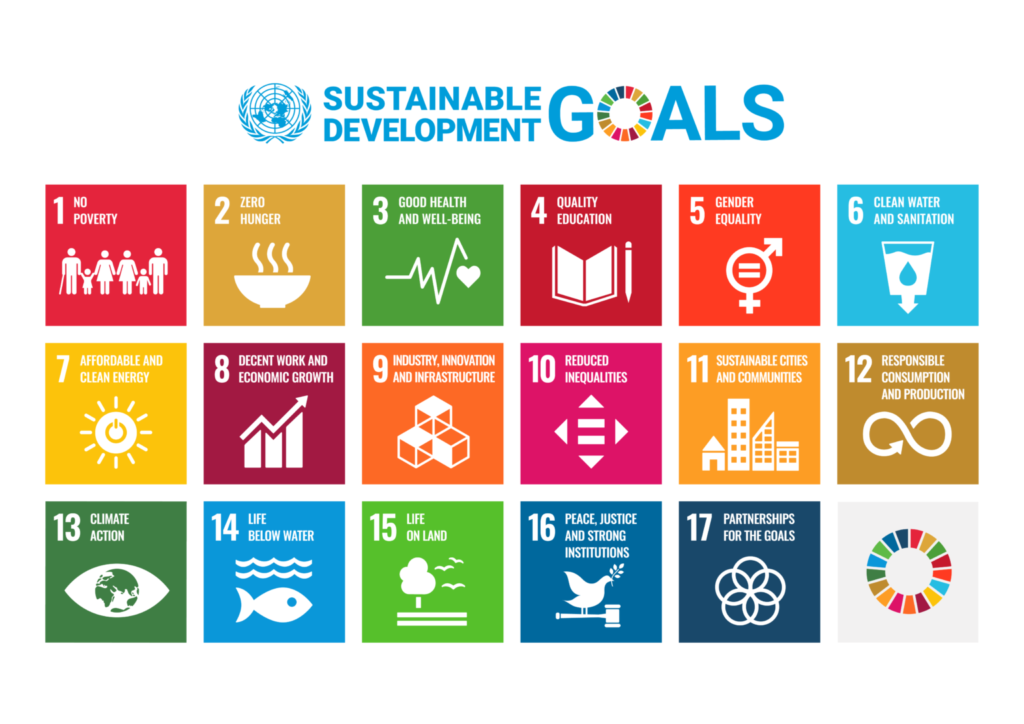In September 2015, all 193 Member States of the United Nations adopted the 2030 Agenda for Sustainable Development with 17 interconnected Sustainable Development Goals (SDGs) as a next step to the Millennium Development Goals set in 2000. The goals are based on five pillars: people, prosperity, planet, peace, and partnership. The focus of the goals is to save the planet, eradicate poverty and ensure prosperity and peace for everyone by 2030. The SDGs, through global partnerships between developing and developed countries, demand urgent action from all countries to deal with global issues such as poverty, inequality, health, climate change, sustainable consumption, innovation and the importance of peace and justice.
Click here for more info on each Goal

A Look at the Sustainable Development Goals Video. This is a short video which provides a brief introduction to the Sustainable Development Goals and the objective and vision behind these goals.
York University and SDGs
Visit The Office of Sustainability for information related to York’s sustainability initiatives, priorities, reports along with resources and links.
Sustainability Mindset
What do we mean by Sustainability and what is a Sustainable Mindset? Oxford Brookes University states "The Sustainability Mindset dimension of the IDEAS model recognises the pivotal role of Higher Education in supporting the knowledge, skills and competencies that students and staff need to develop to contribute to a more sustainable future” (Advance HE and QAA ESD Guidance, 2021).
Although multiple definitions of sustainability exist, this domain presents Education for Sustainable Development (ESD) as an “educational change agenda allowing us to look critically at how the world is and to envision how it might be, supporting learners to create and pursue visions of a better world”.
The urgency of global challenges, such as climate change, biodiversity loss and rising social and economic inequalities, demands we equip today's graduates with attributes necessary to face these challenges and thrive in a complex, uncertain world” (OBU Strategy, 2035).The intentions of this dimension therefore seek reflection and action on this key question:
“How should – and how can – education and learning be re-thought and re-configured to make a significant and central contribution to achieving a more sustainable and just world?” (Sterling, 2001).
Read more from Oxford Brookes University including developing ESD competencies, a sustainability mindset and inclusivity and resources that include question sets, activities and resources, faculty projects, case studies and further reading.
What is Sustainability?
What is sustainability? What do we want to sustain?
An important part of teaching sustainability issues involves keeping these questions open and alive. Sustainability offers a framework for asking enduring questions: What is the good life? How do we create a better world? Thinking and teaching about sustainability are future-oriented projects, but the relevance of sustainability principles and practices must be voiced in the present.
The term sustainability has a place in development literature. In 1983, the United Nations gathered the World Commission on Environment and Development (WCED), known by the name of its chair, Gro Harlem Brundtland. The Brundtland Commission's report, Our Common Future (1987), contains one of the most often cited sustainability definitions:
Sustainable development is development that meets the needs of the present without compromising the ability of future generations to meet their own needs. It contains two key concepts:
- The concept of ‘needs’, in particular the essential needs of the world’s poor, to which priority should be given
- The idea of limitations imposed by the state of technology and social organization on the environment’s ability to meet present and future needs
The scope of sustainability is frequently described as including three spheres – social, environmental, and economic. Below is a Venn diagram that depicts the interdisciplinarity of sustainability as a field of inquiry:
Sustainability is an integrative discipline and a multidisciplinary project. It has statistical, scientific, and humanistic dimensions. With its focus on specific problems and particular solutions, sustainability suggests place-based and project-based approaches to student learning. Teaching towards sustainability also reminds us that pedagogy is a civic project with important ties between classroom and community.
Adapted from Vanderbilt University
